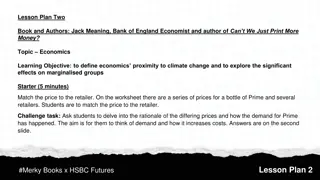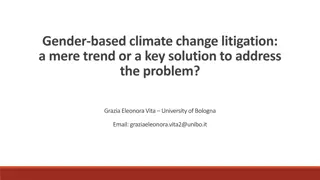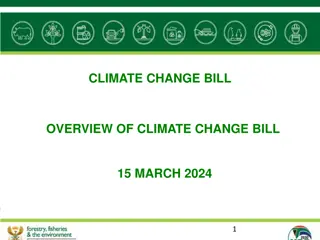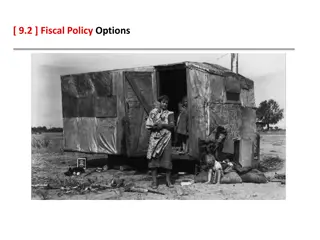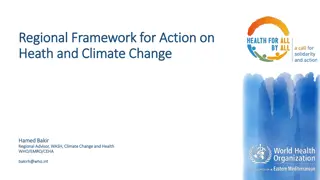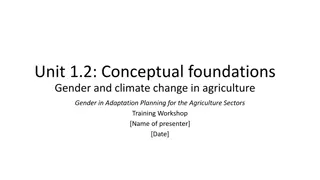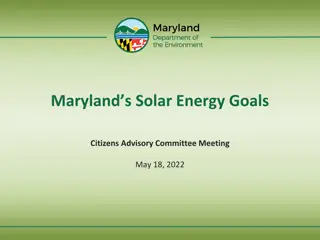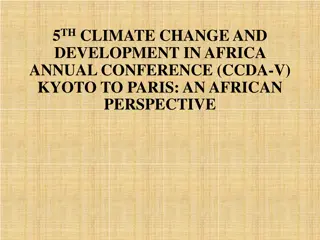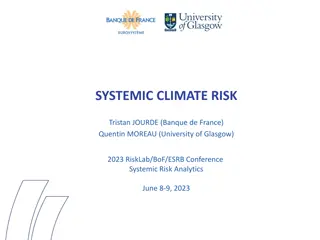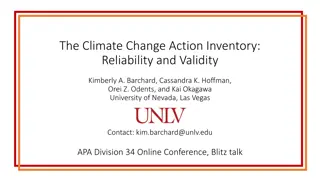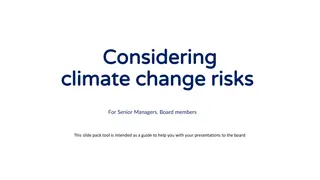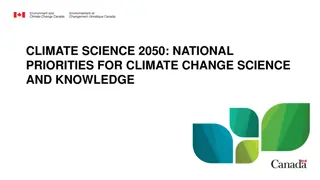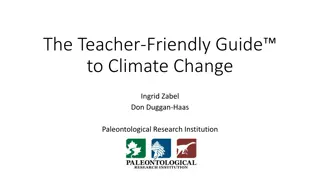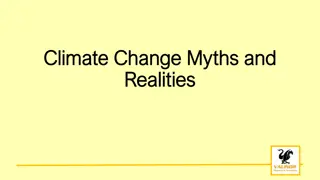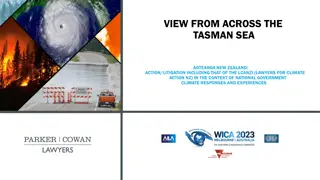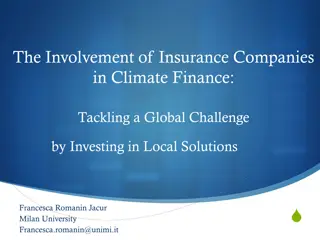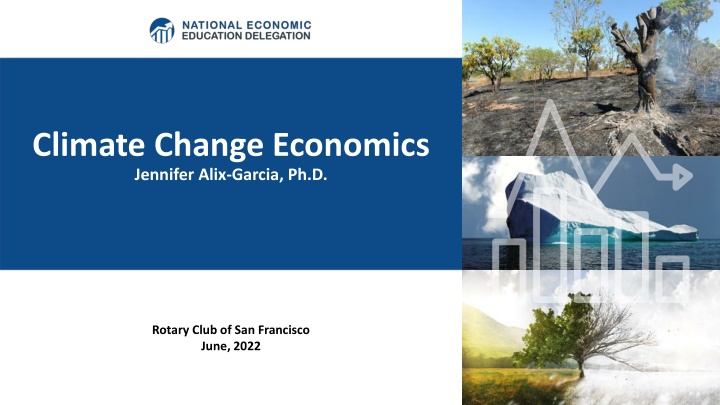
Climate Change Economics
Dive into the intersection of climate change and economics through the lens of Jennifer Alix-Garcia, Ph.D., as she discusses the economic impacts and policy implications of climate change at the Rotary Club of San Francisco. Explore how economists contribute to climate change discussions and the role of the National Economic Education Delegation in promoting economic understanding in policy debates. Discover the importance of balancing economic growth with greenhouse gas emission mitigation and assessing societal preferences for pollution control.
Download Presentation

Please find below an Image/Link to download the presentation.
The content on the website is provided AS IS for your information and personal use only. It may not be sold, licensed, or shared on other websites without obtaining consent from the author. If you encounter any issues during the download, it is possible that the publisher has removed the file from their server.
You are allowed to download the files provided on this website for personal or commercial use, subject to the condition that they are used lawfully. All files are the property of their respective owners.
The content on the website is provided AS IS for your information and personal use only. It may not be sold, licensed, or shared on other websites without obtaining consent from the author.
E N D
Presentation Transcript
Climate Change Economics Jennifer Alix-Garcia, Ph.D. Rotary Club of San Francisco June, 2022
National Economic Education Delegation Vision - One day, the public discussion of policy issues will be grounded in an accurate perception of the underlying economic principles and data. Mission - NEED unites the skills and knowledge of a vast network of professional economists to promote understanding of the economics of policy issues in the United States. NEED Presentations - Are nonpartisan and intended to reflect the consensus of the economics profession. 2
Who Are We? Honorary Board: 54 members - 2 Fed Chairs: Janet Yellen, Ben Bernanke - 6 Chairs Council of Economic Advisers o Furman (D), Rosen (R), Bernanke (R), Yellen (D), Tyson (D), Goolsbee (D) - 3 Nobel Prize Winners o Akerlof, Smith, Maskin Delegates: 590+ members - At all levels of academia and some in government service - All have a Ph.D. in economics - Crowdsource slide decks - Give presentations Global Partners: 45 Ph.D. Economists - Aid in slide deck development 3
Credits and Disclaimer This slide deck was authored by: - Shana Mcdermott, Trinity University - Sarah Jacobson, Williams College - Sharon Shewmake, Western Washington University This slide deck was reviewed by: - Jason Shogren, University of Wyoming - Walter Thurman, North Carolina State University Disclaimer - NEED presentations are designed to be nonpartisan. - It is, however, inevitable that the presenter will be asked for and will provide their own views. - Such views are those of the presenter and not necessarily those of the National Economic Education Delegation (NEED). 4
How Can Economists Contribute to Thinking about Climate Change? By assessing behavioral reactions to climate change. By measuring the damage and estimating the economic costs of fighting climate change. By designing smart policies that minimize costs. - Balance economic growth with GHG emission mitigation. 5
How Much Pollution Does Society Want? Analogy: How Many Oranges Does Society Want? People grow and sell oranges for a price that at least covers costs (supply). People will not pay more for them than what they consider to be their value (demand). Prices let supply and demand balance out. The price settles where: # of oranges people want to sell = # of oranges people want to buy This is the right number of oranges for society. Prices reflect scarcity and the social value of the resource.
Electricity Is Different From Oranges Many sources of electricity generate pollution. Pollution is an EXTERNALITY: - a side effect (cost or benefit) that affects someone else when something is bought or sold. - This is a market failure. The price of electricity does not reflect all of the costs. - Electricity is too cheap. - There is too much pollution.
How These Impacts Affect Humans Reduced fresh water availability Wildfires Shifting zones for important ecosystems, and desertification Reduced worker productivity Increased violence Some of these may cause human migration and/or conflict Agriculture Fisheries Coastal damages Direct health effects, including sickness and death (temperature & drought; also pollution) Indirect health effects (vector- borne disease)
Social Cost of Carbon Cost above price paid. The expected cost of damages from each unit of greenhouse gas emissions. Current EPA estimate: ~$51 per metric ton of CO2. - About $32 Billion for all vehicles in the US. Social cost of carbon will increase over time.
Economics of Responding to Climate Change
How Economists Decide How Much to Fight Climate Change Cost Benefit Analysis Expected costs of reducing emissions Expected damages from allowing climate change Weigh:
Cost-Benefit Analysis of Fighting Climate Change Most economic models suggest the costs of keeping warming below 2 C are relatively small. - Costs amount to 1-4% of GDP by 2030. Costs of acting to keep warming below 2 C are almost certainly less than future economic damages they would avoid. - Damages estimated to be between: 7 - 20% of worldwide GDP. Caveats: - Putting a monetary value on priceless things - Inequality - Uncertainty and risk
Addressing the Sources of Our Emissions
Total U.S. Greenhouse Gas Emissions by Economic Sector in 2018
Wind Turbines Have 100 Times More Power Generation Capabilities Than 30 Years Ago
Policies That Reduce Emissions: Directly Regulation - Emissions standards or limits o E.g., CAFE standards Market-oriented policies - Putting a price on emissions o Subsidizing green energy (e.g., feed-in tariffs) o Tax or cap & trade 20
Policies That Reduce Emissions: INDirectly Subsidizing R&D Grid / infrastructure Energy efficiency mandates and subsidies Mandating renewable energy (e.g., renewable portfolio standards) Land use policies
Carbon Policies Across the World ETS = Emissions Trading System = Cap and Trade Source: World Bank Carbon - Pricing Dashboard
Change in California GDP, Population, and GHG Emissions since 2000 Cap & Trade ->
Summary Climate change is real, is caused by human actions, and has impacts we re already feeling. We need to reduce emissions to balance the costs of action against the costs of inaction. Scientists and the IPCC recommend that we work to keep warming below 1.5 degrees celcius. - Economists believe that this goal is well worth the costs!
Summary continued There are many ways to reduce emissions. Economics-inspired policies can help us do this at the lowest cost. Taxes and cap and trade are proven effective tools to fight climate change! Other tools may also be necessary.
Thank you! Any Questions? www.NEEDelegation.org Jennifer Alix-Garcia jennifer.alix-garcia@oregonstate.edu Contact NEED: Info@NEEDelegation.org Submit a testimonial: www.NEEDelegation.org/testimonials.php 27
Available NEED Topics Include: Coronavirus Economics Immigration Economics US Economy Housing Policy Climate Change Federal Budgets Economic Inequality Federal Debt Economic Mobility Black-White Wealth Gap Trade and Globalization Autonomous Vehicles Minimum Wages US Social Policy 28




